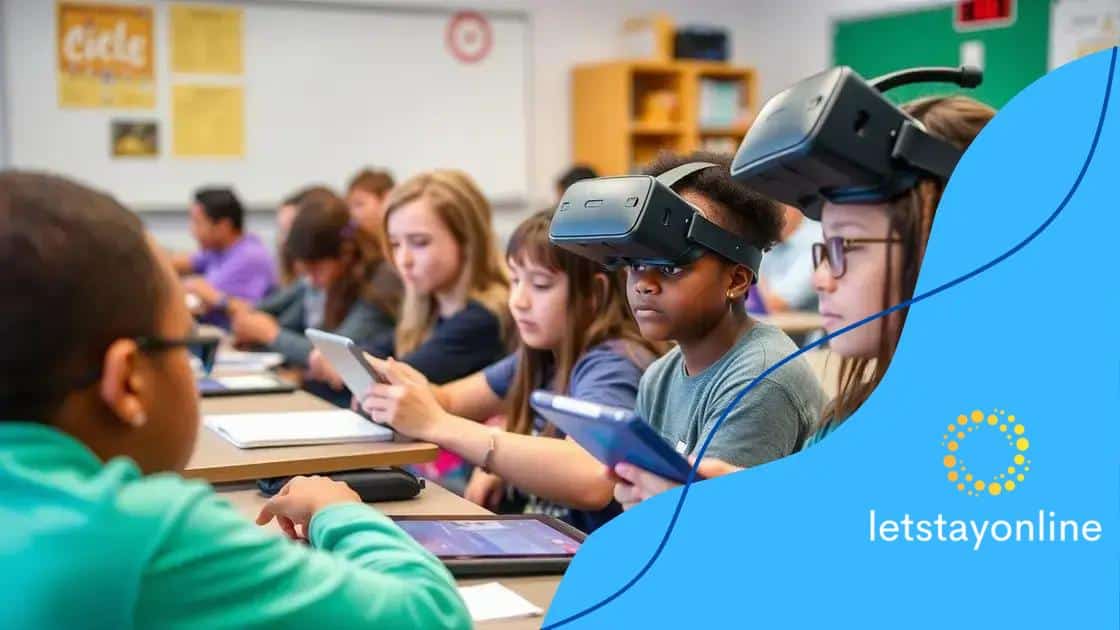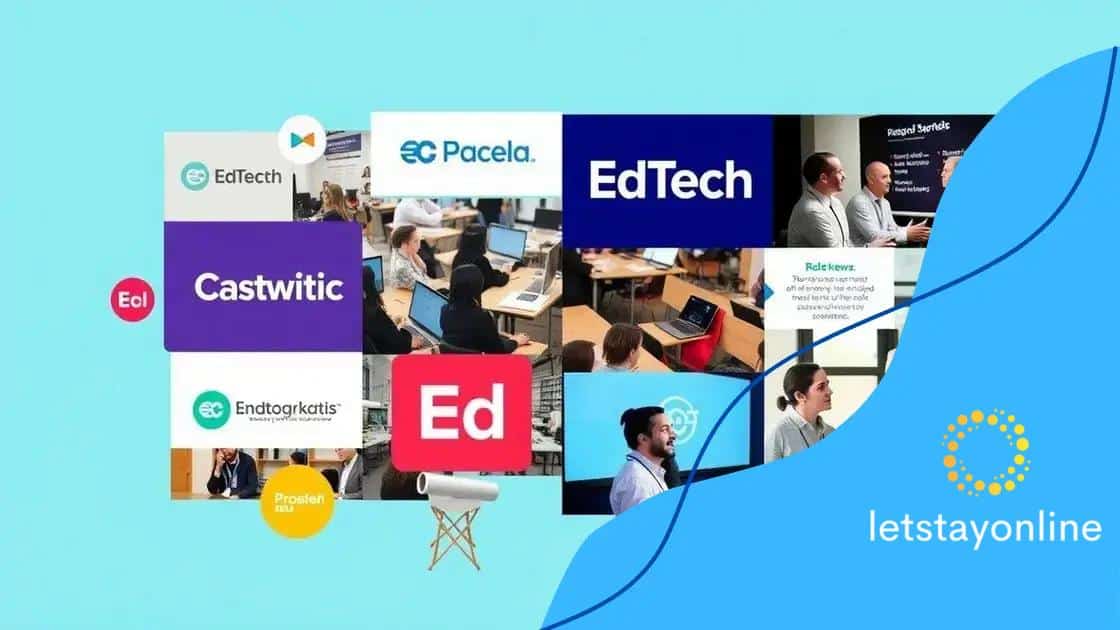EdTech startups revolutionizing education in 2025

EdTech startups are transforming traditional education by enhancing student engagement, personalizing learning experiences, and promoting access and equity, significantly improving educational outcomes for all learners.
EdTech startups revolutionizing education in 2025 promise to reshape how we learn. Have you ever wondered how technology could enhance classroom experiences? In this article, we’ll dive into the exciting changes ahead.
Emerging trends in EdTech for 2025
As we look towards the future, it’s clear that emerging trends in EdTech for 2025 will significantly shape learning environments. With advancements in technology, schools and students will experience a transformation like never before. The integration of innovative tools and methodologies will cater to diverse learning styles and enhance engagement.
Personalized Learning
One of the foremost trends is the rise of personalized learning. This approach tailors educational experiences to the individual needs of each student. Unlike traditional methods, personalized learning utilizes data analytics to track progress and adapt materials accordingly. As a result, learners can advance at their own pace, which fosters a deeper understanding of the subjects.
- Customized learning paths based on interests
- Real-time feedback to improve performance
- Adaptive learning technologies that adjust difficulty
In addition, we are seeing a surge in the use of artificial intelligence within the classroom. AI can analyze student performance and suggest resources that align with their strengths and weaknesses. This not only enhances the speed of learning but also promotes a sense of ownership over the educational process.
Immersive Learning Experiences
Another trend making waves is immersive learning through virtual and augmented reality. These technologies enable students to engage with material in a whole new way. Imagine exploring historical sites or conducting scientific experiments through a VR headset! This kind of learning captures the imagination and makes education more appealing.
- Field trips in virtual worlds
- Hands-on experiences in lab simulations
- Interactive storytelling through augmented tools
Furthermore, social learning platforms are gaining traction as collaborative tools. Students can work together, regardless of location, using online communities to share knowledge and resources. This interaction builds essential skills for teamwork and communication, which are necessary in today’s workforce.
Focus on Mental Health
As we move forward, there’s a growing emphasis on mental health awareness in educational settings. EdTech innovations are not just about academic achievement; they’re also about fostering a supportive environment. Apps and programs designed to promote mental well-being can help students navigate stress and anxiety.
With these exciting trends, the future of education through technology looks promising and filled with potential. By embracing these innovations, we can create more engaging, supportive, and effective learning environments for students everywhere.
Key players in the EdTech startup space

Understanding the key players in the EdTech startup space is crucial for recognizing how education is evolving. Numerous innovative companies are pushing boundaries and transforming traditional learning environments.
Leading EdTech Companies
Among the most notable players are companies like Coursera, Khan Academy, and Duolingo. These platforms have made learning accessible worldwide, offering a variety of courses and subjects through user-friendly interfaces. Each of these companies has a unique approach, catering to different educational needs.
- Coursera: Offers courses from top universities, merging traditional education with online learning.
- Khan Academy: Focuses on providing free educational resources, making learning accessible to all students.
- Duolingo: Revolutionized language learning with its fun, game-like structure that engages users effectively.
In addition, there are emerging startups that are innovating in fields such as augmented reality and personalized learning. Many of them target specific niches, aiming to provide unique educational experiences that conventional institutions may overlook. These startups are pivotal in creating tailored solutions that meet the diverse needs of today’s learners.
Investment Trends
Investment in EdTech has surged in recent years, indicating a strong belief in its future. Venture capitalists are increasingly supporting startups that offer innovative tools for learning and teaching. This influx of funding helps facilitate growth and accelerate the development of cutting-edge technologies.
- Investors are interested in companies focusing on AI and machine learning.
- Funds are directed towards startups promoting remote and flexible learning solutions.
- There’s a significant interest in tools that enhance student engagement through gamification and interactive learning.
The collaboration between established companies and startups is also essential. Many large organizations are partnering with smaller, innovative firms to incorporate fresh ideas and technologies into their offerings. This synergy enhances the effectiveness of educational tools, providing richer experiences for students.
Innovations shaping the future of learning
The innovations shaping the future of learning are transforming how students engage with education. Today’s classrooms are already feeling the effects of new technologies and methodologies that enhance the learning experience.
Adaptive Learning Technologies
One major advancement in education is the rise of adaptive learning technologies. These systems tailor educational content to meet the individual needs of each student. By analyzing a student’s performance, these tools can adjust their learning pathways, ensuring that they focus on areas where they need improvement.
- Real-time assessment of student progress
- Customized assignments based on performance
- Interactive feedback to help students learn effectively
Adaptive technologies not only improve knowledge retention but also make learning more enjoyable. Students can progress at their own pace, which can reduce frustration and build confidence.
Gamification in Education
Another powerful innovation is gamification, which incorporates game-like elements into learning activities. This approach increases engagement by motivating students through rewards and achievements. With gamification, complex subjects become more approachable and less intimidating.
- Points and badges for completing tasks
- Competitive leaderboards to inspire participation
- Fun challenges that reinforce concepts
By adding these elements, educators can create a dynamic learning environment where students are eager to participate and embrace challenges.
Collaborative Learning Tools
Collaboration is also at the forefront of educational innovation. Platforms that facilitate collaborative learning allow students to work together in real time, regardless of their location. These tools enable group projects, discussions, and sharing of resources, making learning a community experience.
Students can connect with peers across the globe, broadening their perspectives and enhancing their learning through shared knowledge. This approach fosters critical thinking and communication skills, which are vital for success in today’s world.
As we move forward, these innovations will play a crucial role in making education more effective and accessible. By integrating technology into learning, we are opening doors to incredible possibilities that will shape the future of education.
Challenges faced by EdTech startups

EdTech startups are vital for the transformation of education, but they face several significant challenges. Challenges faced by EdTech startups can hinder their growth and the impact they aim to make in schools and learning environments.
Market Competition
One major challenge is the fierce competition in the EdTech market. With numerous startups emerging, standing out becomes difficult. Companies need to showcase their unique value propositions clearly. This differentiation is crucial in attracting customers, educators, and investors.
- Identifying a unique niche or approach
- Building brand recognition in a crowded space
- Engaging educators and institutions effectively
In addition to this, many startups struggle with resources and funding. The initial investment required to develop and market their products can be substantial. While venture capital is available, securing it is highly competitive.
Technology Integration
Integrating new technologies into existing educational frameworks also presents challenges. Many schools use traditional methods that may resist adopting innovative tools. Startups must provide clear evidence of the effectiveness of their products to win over skeptical educators and administrators.
- Proving the ROI of new technologies
- Training teachers to use new tools effectively
- Aligning with existing curriculums and standards
Moreover, enhancing user experience is another critical hurdle. If students and teachers find technology cumbersome or unintuitive, their adoption rates will suffer. Companies must prioritize usability and accessibility in product design.
Regulatory Compliance
Regulatory standards can also be a substantial barrier. EdTech startups often need to navigate complex regulations regarding data privacy, security, and accessibility. Ensuring compliance with laws such as FERPA and COPPA can require significant resources and expertise.
These hurdles are daunting, but overcoming them can lead to successful products that revolutionize learning. By addressing these challenges proactively, EdTech startups can create impactful solutions that enhance education.
The impact of EdTech on traditional education
The impact of EdTech on traditional education is profound and far-reaching. Technology is reshaping classrooms, making learning more accessible and engaging for students. Educators now have tools at their disposal that enhance teaching and learning.
Enhancing Engagement
One significant way EdTech impacts education is by enhancing student engagement. Digital tools like interactive apps, videos, and games draw students into lessons, making learning fun and stimulating. When students are engaged, they are more likely to retain information and perform better.
- Interactive quizzes that make assessments fun
- Gamified learning experiences to keep interest high
- Access to multimedia resources that cater to different learning styles
This shift makes traditional education methods feel outdated to some. Educators are now encouraged to incorporate technology into their teaching to create a more dynamic learning environment.
Personalized Learning Experiences
EdTech also allows for personalized learning experiences. Online platforms can adjust to individual student needs, helping them learn at their own pace. This approach supports diverse learning abilities within the same classroom.
By using data, teachers can identify which areas students struggle with and provide targeted resources. This personalized support can lead to improved academic performance and greater student confidence.
Access and Equity
Moreover, EdTech promotes access and equity in education. Students in remote areas can participate in high-quality learning opportunities that traditional schools may not provide. Virtual classrooms and online courses break down geographical barriers, creating equal access for many.
- Access to expert educators through online platforms
- Flexibility in learning environments for diverse students
- Resource sharing that promotes inclusivity
The role of EdTech in traditional education continues to grow, pushing the boundaries of what classrooms can be. With ongoing innovation, the potential for improved learning outcomes is significant. By integrating technology thoughtfully, education can become more effective for all learners.
In conclusion, the integration of EdTech into traditional education is profoundly changing how teachers teach and students learn. By enhancing engagement, personalizing learning experiences, and promoting access and equity, EdTech helps create more inclusive and effective educational settings. As technology continues to evolve, we can expect even greater innovations that will further improve the learning journey for everyone. Embracing these changes can lead to a brighter future for education, where every student has the tools they need to succeed.
FAQ – Frequently Asked Questions about EdTech’s Impact on Education
How does EdTech enhance student engagement?
EdTech enhances student engagement by using interactive tools like games, quizzes, and multimedia resources that make learning fun and immersive.
What is personalized learning in EdTech?
Personalized learning refers to adaptive technologies that tailor educational experiences to meet the individual needs of each student, allowing them to learn at their own pace.
In what ways does EdTech promote access and equity in education?
EdTech promotes access and equity by breaking down geographical barriers and providing high-quality learning opportunities to students regardless of their location.
What future innovations can we expect in EdTech?
We can expect ongoing advancements in EdTech that will enhance the learning experience, such as virtual reality, artificial intelligence, and more personalized educational tools.






